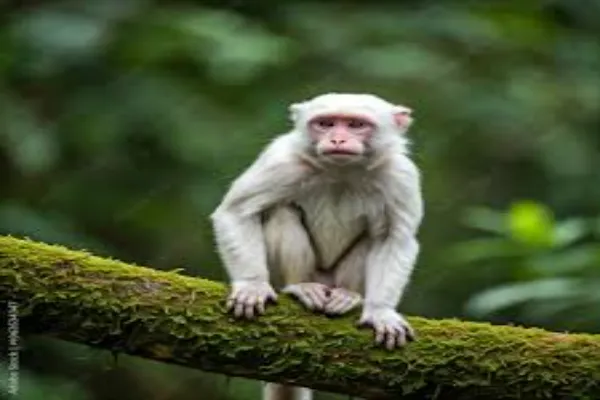Monkeys, with their diverse range of species and behaviors, have captivated the human imagination for centuries. Among them, there is a rare and incredibly unique phenomenon: the albino monkey. These creatures, born with a genetic mutation that prevents the normal production of melanin, resulting in a lack of pigmentation, are both awe-inspiring and mysterious. Albino monkeys are not only a visual spectacle but also a symbol of nature’s complexity and the marvels of genetic diversity. In this article, we will explore the characteristics of albino monkeys, the reasons behind their rarity, the implications of their albinism, and some notable examples of albino monkeys in the wild and in captivity.
What is Albinism?
Albinism is a genetic condition that results in a lack of melanin in the skin, hair, and eyes. Melanin is the pigment responsible for giving color to an animal’s body, including its fur, skin, and eyes. In albino animals, including monkeys, the absence of melanin causes a distinctive look: very pale fur, light-colored or pinkish skin, and often red or light-colored eyes. The mutation that causes albinism can happen in several ways, most often as a recessive trait passed down through generations.
In primates, albinism can occur in various species, although it is extremely rare. This rarity is due to the fact that both parents must carry and pass on the albino gene for their offspring to exhibit the condition. Even if only one parent carries the gene, the chances of having an albino offspring are extremely slim.
Physical Characteristics of Albino Monkeys

Albino monkeys, like their non-albino counterparts, belong to a wide variety of species, including both Old World monkeys and New World monkeys. However, regardless of the species, there are a few physical traits that define an albino monkey:
- Fur Color: The most striking feature of albino monkeys is their fur, which is typically white or very pale cream. Some may have hints of a faint yellowish or reddish tint, but the overall appearance is markedly lighter than that of a normal monkey of the same species.
- Eyes: Albino monkeys often have pink or red eyes. This is because the absence of melanin makes the blood vessels in the eyes more visible, creating a reddish or pinkish appearance. The eyes may also appear more sensitive to light because of the lack of pigmentation.
- Skin: Their skin can appear pale or pinkish, much lighter than that of typical monkeys, which tend to have darker skin tones.
Causes of Albinism in Monkeys
Albinism in monkeys, like in other animals, is caused by a genetic mutation in the gene responsible for producing melanin. There are different types of albinism depending on the specific gene involved. This condition is usually inherited in a recessive manner, meaning that both parents must carry the gene for their offspring to be affected.
In some cases, albinism can be the result of a spontaneous mutation that occurs in a single individual. When this occurs, the mutation can be passed on if the albino individual reproduces. However, the likelihood of this mutation being passed down is low unless both parents are carriers of the albino gene.
How Rare are Albino Monkeys?
Albino monkeys are incredibly rare. While the exact number is difficult to determine due to the elusive nature of many primate species, it’s generally accepted that the occurrence of albino individuals in monkey populations is one of the most unusual phenomena in the animal kingdom. Albino monkeys are so rare that some species might only have a handful of confirmed cases in the wild.
This rarity is partly due to the genetic makeup of monkeys. As mentioned earlier, albinism is a recessive trait, so both parents must be carriers for the offspring to be affected. Furthermore, albinism can lead to several health complications, making it harder for albino individuals to survive in the wild. The lack of pigmentation in their fur and skin makes them more vulnerable to the sun’s rays, as they have no natural protection against UV radiation. Albino monkeys also tend to have vision problems because the lack of melanin affects the development of the eyes.
Survival Challenges for Albino Monkeys
While the visual appeal of an albino monkey might capture the attention of onlookers, the condition often comes with numerous survival challenges. These challenges are due to the lack of pigmentation, which plays a crucial role in protecting animals from the environment. Some of the key survival challenges that albino monkeys face include:
- Sunlight Sensitivity: In the wild, sunlight exposure can be particularly damaging to albino monkeys. Without melanin, they are more susceptible to sunburn and UV damage. In some cases, prolonged exposure to the sun can lead to skin damage or even skin cancer. Albino monkeys must often avoid direct sunlight to reduce the risk of harm.
- Vision Problems: Melanin plays a vital role in the development of the eyes. Albino monkeys may suffer from vision issues, such as poor eyesight, sensitivity to light (photophobia), and an increased risk of retinal damage. This can make it harder for them to navigate their environment and spot predators.
- Predation: The lack of camouflage due to pale fur makes albino monkeys easier targets for predators. In the wild, an albino monkey’s pale coloring can make it stand out in a group, making it easier for predators to spot them. As a result, albino monkeys may have lower chances of survival in the wild compared to their normally pigmented peers.
- Social Isolation: In some cases, albino monkeys might face social challenges as well. In tight-knit monkey communities, individuals with unusual traits like albinism may be treated differently by others, sometimes leading to social isolation. Social cohesion is important for the survival of many primates, and being seen as different can sometimes reduce an albino monkey’s chances of forming strong social bonds.
Notable Albino Monkey Sightings

Despite the challenges, albino monkeys have been spotted in the wild and have even captured the fascination of the public when discovered in zoos and wildlife sanctuaries. One of the most famous albino monkeys was a rare albino macaque, spotted in China. This albino macaque made headlines due to its rarity, and the animal’s distinct look attracted attention from researchers and animal enthusiasts alike.
Another noteworthy case involves albino capuchin monkeys. Capuchins are a species of New World monkey often seen in Central and South America, and albino individuals are extremely rare within this species. An albino capuchin was once discovered in a wildlife sanctuary, and its presence highlighted the rarity of albinism in this species.
Additionally, albino monkeys have been born in captivity, where their rare genetics can be studied more closely. Zoos and sanctuaries around the world have seen rare albino births, sparking interest in their genetic makeup and the challenges of caring for such a unique animal.
The Role of Albino Monkeys in Conservation Efforts
Despite the survival difficulties faced by albino monkeys, they can contribute to important conversations about biodiversity, genetics, and conservation. Albino monkeys remind us of the delicate balance in the natural world, and they serve as a visual representation of genetic mutations that can both enrich and complicate the survival of a species.
Conservation efforts aimed at preserving monkey populations, including albino individuals, are vital to maintaining genetic diversity. These efforts include protecting habitats, ensuring healthy breeding populations, and raising awareness about the potential challenges that rare genetic conditions like albinism can present.
Conclusion
Albino monkeys are rare and fascinating creatures that embody the wonders and challenges of the natural world. Their unique appearance, caused by a lack of melanin, sets them apart from their peers, but it also brings with it a host of survival challenges. As we continue to learn more about these animals, it’s important to recognize their value in the broader conversation about animal conservation, genetic diversity, and the role of rare genetic traits in the survival of species.
Whether in the wild or in captivity, albino monkeys are a reminder of the complexity of life on Earth, showing that sometimes nature’s most extraordinary creations are also the most fragile. As we strive to protect endangered species and preserve biodiversity, let’s also remember the rare and precious albino monkeys that grace our planet with their beauty and uniqueness.
